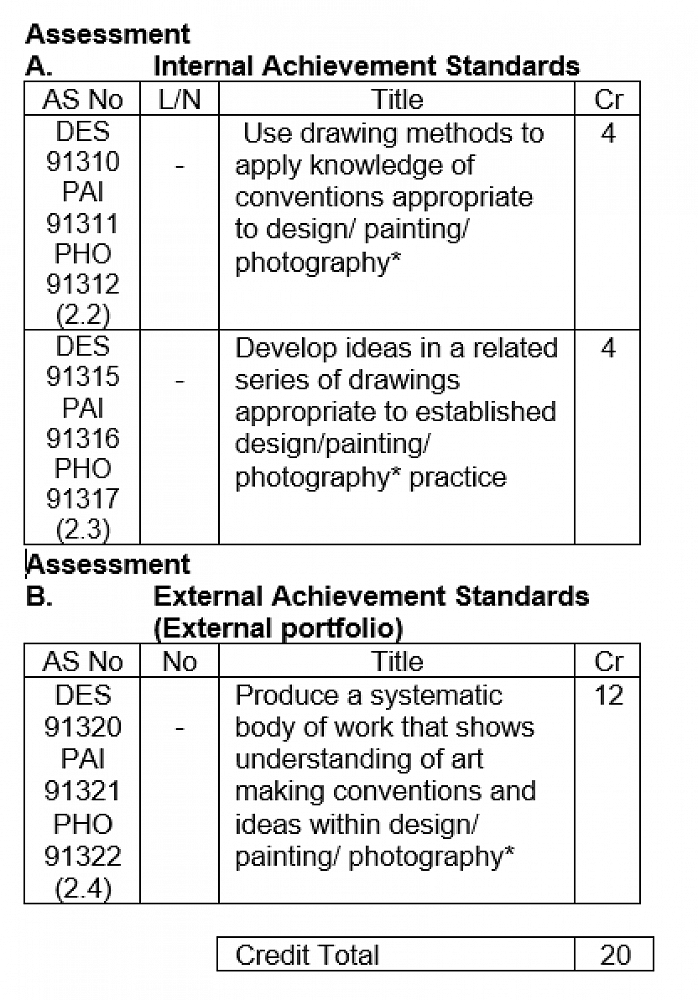Visual Arts - Design, Painting, Photography: Level 2
Qualification - NCEA level 2
Course Outline
Students studying Level 2 Visual Art are actively engaged in developing an understanding of the Arts in context, developing practical knowledge, developing the ability to generate and manage ideas, and looking at how meanings are communicated through interpretation of images.
Emphasis at this level is on research and analysis of artistic practice, and the demonstration of understanding in making art appropriate to discrete Visual Art fields of study. In all fields of study, students will follow and learn from the methods and ideas of a diverse range of artist models, and engage with the Visual Art Curriculum in a fun and challenging way. Key Competencies are developed and learned through art-making activities.
Students may elect to study in one or more Visual Art fields of study from Design, Painting and Photography. Each field of study is a separate Level 2 subject.
Prerequisite
Entry into any Level 2 Visual Art field has the prerequisite of Level 1 Visual Art, or in consultation with the HOD of Visual Art. Please note: At the consultation meeting, prior learning and recent evidence of interest in the Visual Arts will be used to determine a student’s suitability for the course. Please ensure that this is made available.
Future pathway: Students may choose to continue their learning experience within their chosen field or another, at Level 3.
DESIGN
Course Outline
This course of study extends students’ ability to research, generate, and clarify visual ideas through a series of related practical design projects.
Through research, students will learn how to identify and use design conventions from contemporary and historical practice. Students will be involved in gathering ideas for their own use from a range of design sources and will produce work that documents design processes and procedures. Students are encouraged to express and resolve design issues with an individual solution. Drawing is used as a means of researching, planning, and visualizing ideas.
Students will receive training in the use of the Adobe Illustrator programme as a means to produce contemporary design solutions.
Students will have the opportunity to select their own subject matter to extend through a specific area of design. Students’ understanding of art-making methods and ideas in the field of design will be presented as a two-panel folio for external assessment
PAINTING
Course Outline
In this course of study, students will use drawing in many forms as the central means to research and generate ideas. Students will learn about and then employ the techniques and processes of selected artist models as a means of informing, developing and clarifying the direction and progress of their own ideas.
Students will investigate contemporary and traditional approaches to image-making and will provide evidence of understanding of artistic practice of personal interest and relevance to their work.
Students are asked to demonstrate an understanding of art-making methods and ideas in the field of painting on a two-panel folio for the externally assessed Achievement Standard.
PHOTOGRAPHY
Course Outline
This course of study introduces students to the processes and procedures of photography and image-making using photo-based media.
The course of study will involve research into existing photographic practice and documentation of processes used by photo artists.
Students will investigate and put into practice a variety of photographic processes and procedures, both with and without the camera using digital media. This research and practical exploration is intended to enable students to generate and develop ideas. Students will then have the opportunity to explore individual ideas within an established framework and complete a practical investigation that shows an understanding of art-making conventions and ideas within the field of photography.
Students are encouraged to have their own DSLR camera, as independent learning and image-production are more easily accessed by this means. However, the school has some cameras for loan. Modern phone cameras are also suitable for use as long as students make appropriate settings adjustments. Students and caregivers are advised to discuss their options with the teacher in charge of photography if they wish to purchase a camera prior to the commencement of the course. It is expected that students bear the individual cost of photographic materials. These need not be prohibitively expensive, though this should be taken into consideration when selecting this course.

